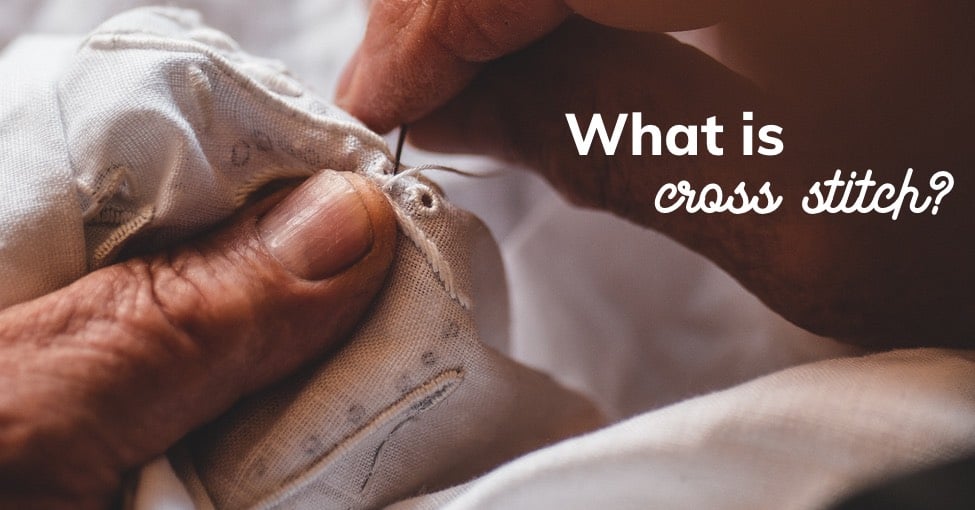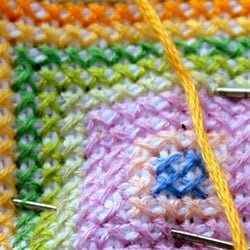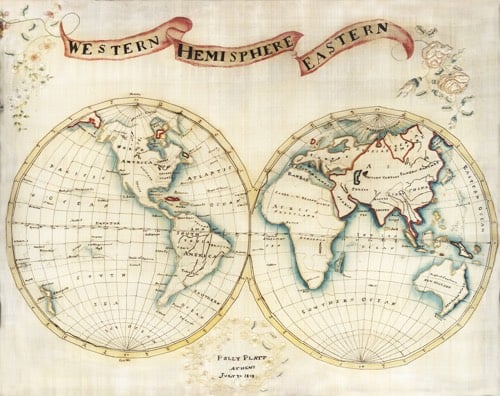What is cross stitch?

What is cross stitch? To answer that question we need to first learn a little more about embroidery.
What is embroidery?
The word ‘embroider’ comes from the French ‘broder’ meaning to prettify, adorn, decorate.
Embroidery – the art of embellishing fabric using needle and thread. This thread was often silk, cotton, or fine wire like gold or silver.
Common embroidery types include crewel work, needlepoint, cross-stitch and quilting.
So what is cross stitch?
Cross-stitch is a type of embroidery worked on canvas or evenly woven fabric. The fabric consisting of weave strands that are easy to count.

According to The dictionary of needlework:
Its beauty consists of its points being enclosed in a perfect square. To work: Take the first part of the stitch from the left-hand bottom side of the square across to the right-hand top side, and the second from the right-hand bottom side to the left-hand top side, crossing over the first stitch.
Cross-stitch was once known as opus pulvinarium (a Medieval Latin term meaning shrine or cushion work). Oriental work and a few fragments from Egypt show early examples of this stitch. By the 19th century it was also known as Berlin work.
Other names for cross stitch include Point de Marque and Kreuzstich Stickerei (when used on thick fabrics). Depending on the ‘count’ of the fabric, it is sometimes called petit point, gros point or quick point. But these names are more common when discussing needlepoint.
There are several forms of cross stitch patterns:
- Stamped cross stitch – small crosses (X) printed on a tight-weave fabric (e.g. cotton with no holes as used in bed linen etc). The stitcher would then stitch over each X to make the design.
- No-count cross stitch – the pattern is dyed on to the fabric (e.g. Aida). Stitchers follow the colours on the fabric while they stitch.
- Counted cross stitch – there are no marks or patterns on the fabric (i.e. “clean skin” Aida, linen, etc). A paper or electronic pattern provides the instructions for stitching the design.
Was embroidery a common hobby?
Before machine-made materials, fabric and coloured yarn was expensive. Because of the expense, stitches were sewn on very small parts of fabric. These became known as samplers. Less wealthy folk (commoners) dyed their own thread and may have used punched paper in place of fabric. This paper was also known as perforated paper or perforated card-board.
Meant to teach sewing, samplers helped girls remember their alphabet and numbers. They were often used to teach moral values and to memorise versus from the bible.
During the 17th century, sampler making was very common in Europe and the Americas. During the 18th century pattern books began to appear. This caused sampler content to change. Samplers became decorative and were a showcase of the young girl’s sewing abilities.

Map sampler made at Pleasent Valley Quaker Boarding School (1809) by Polly Platt. (Image from rawpixel.com / The Metropolitan Museum of Art (Source)
References
- CAULFEILD, S. F. A., & SAWARD, B. C. (1890, 2nd edition). The dictionary of needlework: an encyclopaedia of artistic, plain, and fancy needlework dealing fully with the details of all the stitches employed, the method of working, the materials used, the meaning of technical terms, and, where necessary, tracing the origin and history of the various works described. London, A.W. Cowan. https://archive.org/details/dictionaryofnee02caul.
- “A Short History of Cross Stitch” https://ezinearticles.com/?A-Short-History-of-Cross-Stitch&id=7290624
- ALFORD, M. M. C. C. (1886). Needlework as art. London, S. Low, Marston, Searle, and Rivington. http://catalog.hathitrust.org/api/volumes/oclc/352674.html
- “Cross-stitch embroidery” https://www.britannica.com/art/cross-stitch-embroidery
- “Embroidery” https://www.britannica.com/art/embroidery
- “History of cross stitch” http://juliesxstitch.com/history-of-cross-stitch
- “Needlepoint” https://www.britannica.com/art/needlepoint
- “Perforated paper” https://en.wikipedia.org/wiki/Perforated_paper
- “Threads of History” by Jo Verso https://www.thecrossstitchguild.com/cross-stitch-basics/stitchers-study/threads-of-history-by-jo-verso.aspx
